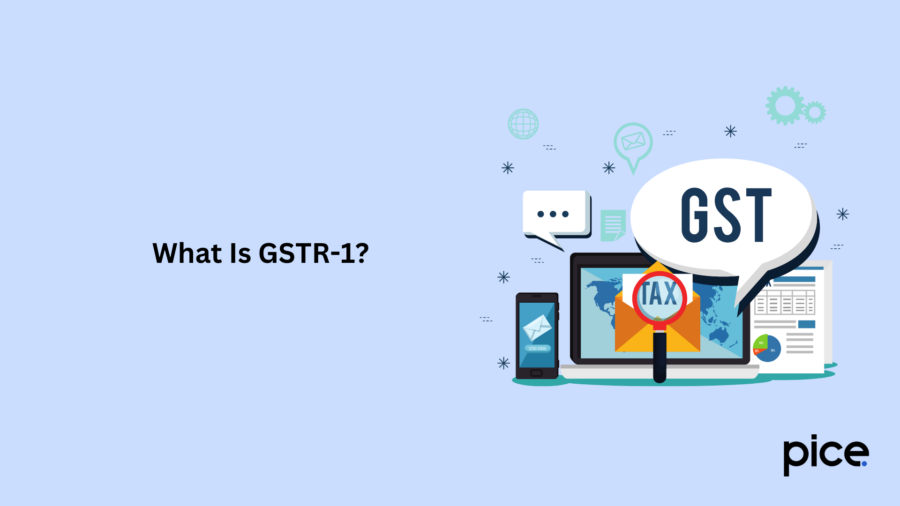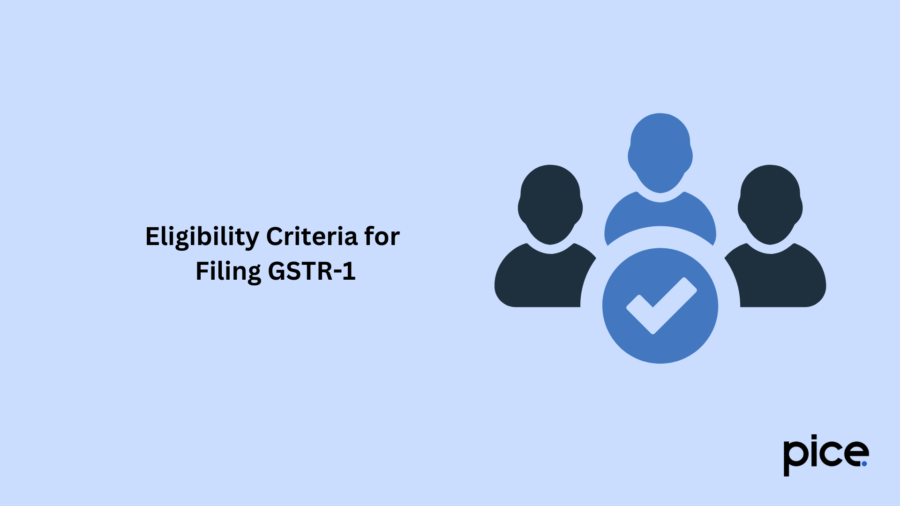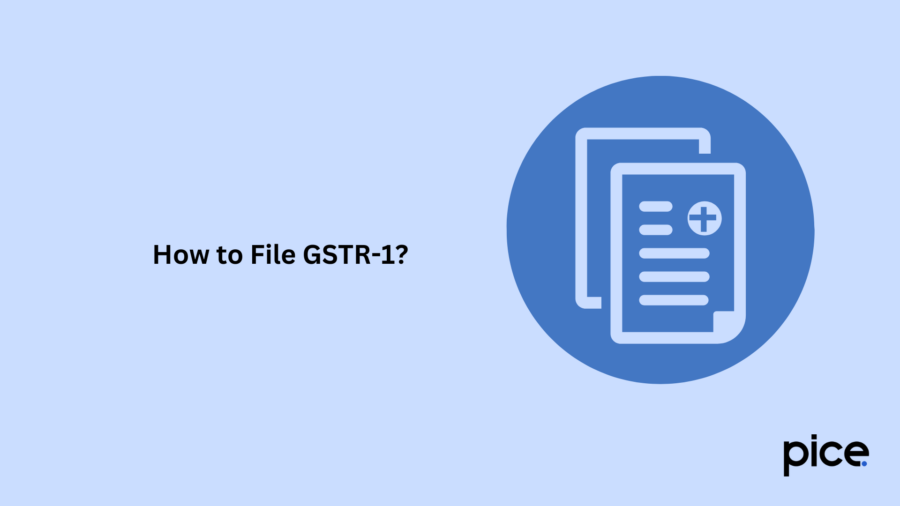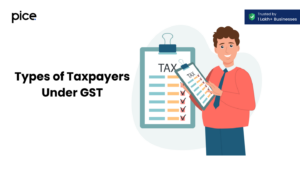GSTR 1 Late Fees & Interest Details
- 30 Jan 25
- 12 mins

GSTR 1 Late Fees & Interest Details
Key Takeaways
- GSTR-1 is mandatory for GST-registered businesses to report sales.
- Timely filing prevents penalties and ensures correct ITC claims.
- Due dates: 11th (monthly) & 13th (quarterly under QRMP).
- Late fees apply for delays, but reduced since June 2021.
- Filing via SMS is available for convenience and compliance.
To avoid unwanted litigation, it is crucial to file GSTR-1 returns on time for anyone registered under the GST Act. This is a preset form that declares an entity’s income details and also mentions their income tax liabilities during a particular cycle.
You can continue reading this blog to know the format and tentative deadline, along with GSTR-1 late fees for applicable candidates.
What Is GSTR-1?

GSTR-1 is a crucial official document within the GST system that enlists particulars of all outward supplies or sales completed by GST-registered taxpayers within a specific period.
Businesses must file this return on time to comply with the legal guidelines. Also, it enables them to claim the correct input tax credit (ITC) amount, avoid potential fines, and promote transparency in transactions. Finally, filing the GSTR-1 helps to reconcile commercial data with suppliers and establish trust within the business network.
All GST-registered businesses must submit their GSTR-1 returns on a monthly or quarterly basis. For the government, it boosts the overall revenue collection and serves as an important indicator when it comes to considering tax policy decisions. All in all, the GSTR-1 is a comprehensive source of income tax-related information that plays a pivotal role in maintaining transparency and integrity in taxation.
Format of GSTR-1
Knowing the format is particularly important to overcome compliance-related issues and avoid GSTR-1 late fees, penalties, or interest. The GSTR-1 Form includes several fields where business representatives need to provide detailed inputs.
Overall, there are 15 tables where a supplier must mention specific details about the services or goods they have sold during a certain period (month or quarter). Nonetheless, you must note that not all tables need to be addressed by every supplier.
As a GST-registered supplier, you should fill out only those fields that are relevant to your business or the nature of commodities or services you provide. Here, we have described the format in detail:
| Tables | Description |
| Table 1, 2 and 3 | Must have the GSTIN of the registered supplier besides their legal and trade names. Also, the business representative needs to mention the total turnover for the preceding year. |
| Table 4 | Here, the supplier has to mention their aggregate value of taxable outward supplies, not including zero-rated supplies and export bills. |
| Table 5 | Table 5 includes the total value of taxable interstate supplies made towards GST-unregistered dealers. The invoice amounts must be lower than ₹2.5 lakh. |
| Table 6 | Features information about all zero-rated supplies along with deemed exports. |
| Table 7 | Sales made to dealers who are not registered under the GST law, excluding those that are already mentioned in Table 5. |
| Table 8 | Used for reporting exempt, nil-rated, and non-GST outward supplies. |
| Table 9 | This section is accessed to list down amendments made to the taxable outward supplies given in Table 4, Table 5 or 6 of the Form GSTR-1 filed during the previous taxation cycle. |
| Table 10 | Includes the debit notes and credit notes provided to dealers who are not registered under the GST law. |
| Table 11 | Here, you can include information regarding adjustments made or advances received in the present tax period. Also, there is room to mention amendments made to the information reported during the previous tax cycle. |
| Table 12 | This table is a summarisation of outward supplies made and is represented by different Harmonised System of Nomenclature (HSN) codes. |
| Table 13 | By using this table, a supplier can provide details about documents generated in a specific tax cycle. Some appropriate documents in this section comprise debit notes, credit notes, delivery challan, invoices and other similar records. |
| Table 14 | It has the sales records of Electronic Commerce Operators (ECOs) designated under GSTIN. |
| Table 14A | Suppliers need to mention the amendments done to content in Table 14 under this section. |
| Table 15 | It has the sales records of Electronic Commerce Operators (ECOs) designated under the supplier’s GSTIN. |
| Table 15A | E-commerce operators need to mention changes made to Table 15 for B2B sales and B2C sales in Table 15A I and Table 15A II respectively. |
Eligibility Criteria for Filing GSTR-1

Any business or self-employed individual registered under GST must access the GSTR-1 Form. Even if there are no business activities during a particular tax period, then also following this guideline is mandatory.
When registered taxpayers fail to file GSTR-1 returns on time, they are liable to pay GSTR-1 late fees. From July 2020, the government has also enabled GSTR-1 submission via SMS for interested taxpayers to further streamline the filing process.
Below you can find a list of GST-registered entities that are not required to file GSTR-1 returns. This information can also be verified on the GST portal.
- Registered Taxpayers Who Can Collect TCS or Tax Collected at Source as Per Section 52 of the CGST Act: Section 52 necessitates ECOs collecting TCS on specific supplies sold via their platform.
- Composition Dealers: Businesses that do not cross an annual turnover of ₹1.5 crore can skip filing the GSTR-1 Form. However, for this facility, they must register under the composition scheme.
- Non-resident Taxable Persons: Under this head come individuals who occasionally engage in transactions involving taxable supplies. In these deals, they participate either as a principal party, agent, or other similar role and do not have a permanent address within the territorial boundaries of the country.
- Input Service Distributors: As per the GST law, it signifies a business’ branch or facility that gets tax invoices. However, these establishments allocate the tax credit to their branch outlets.
- Service Providers Offering Online Information and Database Access or Retrieval (OIDAR) Services: Under this segment comes businesses that directly process payments, as mentioned in Section 14 of the IGST Act, of 2017.
- Registered Taxpayers Who Need to Deduct Tax Deducted at Source or TDS as per CGST Act, of 2017: Section 51 of the CGST law enables the following parties to collect TDS:
- Local Authority
- An establishment or regulatory authority working under the State Government or Central Government
- Government bodies (Categories of people as declared by the Government based on the recommendations of the GST Council)
GSTR-1 Due Date
The due dates for filing GSTR-1 vary depending on the aggregate turnover of a business. Here’s a breakdown of the same:
- For Businesses Having a Turnover Exceeding ₹5 Crore
These businesses need to file GSTR-1 each month. The entrusted person must submit the form within the 11th of the following month. For instance, the form for the month of January 2025 needs to be uploaded by 11th February 2025. This rule continues for each of the subsequent months.
- For Businesses Having a Turnover of Less Than ₹5 Crore and Registered Under the QRMP Scheme
These taxable persons can file GSTR-1 quarterly. If you fall into this category, you can settle the dues of the previous quarter within the 13th of the month of the subsequent quarter. For instance, the due date for filing GSTR-1 for the period October to December 2024 will be the 13th of January 2025.
This system enables taxpayers to follow the GST rules seamlessly and strategically avoid the GSTR-1 late fees.
How to File GSTR-1?

If you are unsure about how to file Form GSTR-1, then consider following the steps given below:
Step 1: Open the official website of GST and log in to your GSTIN account.
Step 2: Navigate to the ‘Services’ tab.
Step 3: Click on ‘Returns’ and select the option of ‘Returns Dashboard’.
Step 4: Mention the correct Financial Year followed by the relevant Return Filing Period by using the dropdown menu.
Step 5: Click on ‘Search’.
Step 6: Upon opening the search results, go to ‘Details of outward supplies of goods or services’ and click on ‘Prepare Online’. If your invoice count exceeds 500 then opt for the ‘Prepare Offline’ option.
Step 7: Address the relevant sections.
The GSTR-1 dashboard will offer you a total of 19 sections. As a registered taxpayer, you are only responsible for addressing the segments that align with the nature of your supplies. However, a few of them are auto-populated.
Here, you can take a brief look at all the important sections:
- A section that is auto-populated showing the GSTIN of the supplier submitting the return
- An auto-populated field displaying the name of the taxpayer filing the return
- A section with the total turnover of the preceding fiscal year needs to be filled. Then, it instantly auto-populates the form featuring the closing balance as of then
- A field with specifications of the taxable outward supplies made to a GST-registered person
- Details about the outward inter-state supplies made to an end consumer if the transaction crosses ₹2.5 lakh
- A section comprising zero-rated supplies along with deemed exports to SEZs and EOUs accompanying the specifications of invoices, bill of export, shipping bills, and so on
- A cumulative report of the monthly outward supplies covering those made through e-commerce platforms and not exceeding the limit of ₹2.5 lakh
- Particulars of non-GST, nil or exempted supplies in case they are not already mentioned in other areas of the GSTR-1 Form
- Any corrections or amendments that have to be reflected for the outward supplies from preceding tax periods, comprising credit/debit notes alongside refund vouchers
- Specifications of saleable products or services that are listed as HSN codes
- Taxes due to advance settlements received
- Any tax amount settled for the past tax periods or reporting sessions
- Documents produced within a period for which the supplier files GSTR-1 From along with new and revised invoices, debit notes and credit notes
What Do You Need to File GSTR-1?
You must have the below-mentioned documents and information updated and ready before you proceed to file the GSTR-1 form.
- A genuine and valid Goods and Services Identification Number (GSTIN)
- Aadhaar number (valid for suppliers who wish to e-sign the form)
- Your GST account’s user ID and password which is necessary to sign in to the portal
- A digital signature certificate (DSC) unless the GST Council permits you to e-sign the form, a facility made available for certain suppliers only
- Ready access to the mobile number that you linked to your Aadhaar card
What Are the Late Fees That Can be Incurred on GSTR-1?

The following table will give you a detailed idea about the GSTR-1 late fees (excluding cases where nil GSTR-1 filing is required):
| Name of the GST Act | Late Fees Applicable After Every Day of Delay | Maximum Late Fee (When the Yearly Turnover of the Last Financial Year is up to ₹1.5 Crore) | Maximum Late Fee (For Cases When the Annual Turnover is Ranging Between ₹1.5 Crore - ₹5 Crore) | Maximum Late Fee (When the Turnover Exceeds ₹5 Crore) |
| Central Goods and Services Tax (CGST) Act, 2017 | ₹25 | ₹1,000 | ₹2,500 | ₹5,000 |
| Corresponding State Goods and Services Tax (SGST) Act, 2017 or Union Territory Goods and Services Tax (UTGST) Act, 2017 | ₹25 | ₹1,000 | ₹2,500 | ₹5,000 |
| Total GSTR-1 Late Fees to be Settled | ₹50 | ₹2,000 | ₹5,000 | ₹10,000 |
In another table (listed below), you can check the late fees applicable for nil GSTR-1 filing:
| Name of the GST Act | Late Fees Applicable After Every Day of Delay | Maximum Possible Late Fee |
| CGST Act, 2017 | ₹10 | ₹250 |
| Corresponding UTGST Act, 2017 or SGST Act, 2017 | ₹10 | ₹250 |
| Total Payable Late Fees | ₹20 | ₹500 |
Originally, the late GSTR-1 filing fees used to be ₹100 for each delayed date as per the CGST Act under its respective SGST/ UTGST Act. Additionally, Nil return filers had to bear an extra ₹25 penalty for each delayed date as per CGST law and the corresponding SGST/UTGST Act.
Later on, the Central Board of Indirect Taxes and Customs (CBIC) minimised the late fee structure to ensure a bit of relaxation for business owners who find it difficult to file GST returns. Moreover, they published an official declaration 20/2021 on June 1, 2021, which capped the maximum late charges effective from June 2021 onwards.
Conclusion
While filing the GSTR-1 form, it is essential to keep in mind certain aspects to avoid unwanted trouble later on. You should be aware of the due dates to avoid paying GSTR-1 late fees to the GST Council. For assistance in this matter, consider connecting with experts who can help you manage business compliance needs in a smooth fashion.
💡If you want to streamline your payment and make GST payments, consider using the PICE App. Explore the PICE App today and take your business to new heights.
 By
By 
















